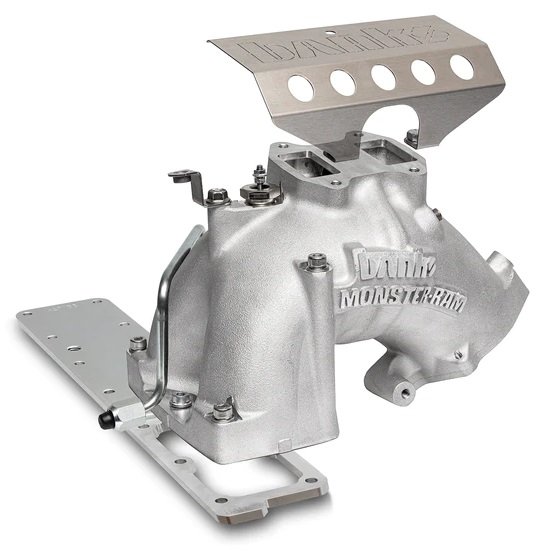
Regarding diesel performance, airflow modifications are among the most effective upgrades available. For owners of the 6.7L Cummins engine, two components stand out: the grid heater and the intake horn. While the Cummins 6.7 grid heater is designed to warm incoming air for smoother cold starts, it can sometimes limit airflow.
Conversely, an upgraded intake horn refines how air is delivered to the engine. This article explores the intricacies of the 6.7 Cummins grid heater and the benefits of a performance intake horn, helping you decide how to optimize your engine for maximum power, efficiency, and reliability.
Rethinking the Grid Heater: Function and Challenges
What Does the Grid Heater Do?
The grid heater in your 6.7 Cummins engine is built into the intake system to pre-warm incoming air during cold weather. This heating process aids in the following:
- Fuel Vaporization: Warmer air improves fuel atomization, leading to smoother and more reliable cold starts.
- Reduced Emissions at Startup: Pre-heated air minimizes white smoke during initial ignition by ensuring better combustion.
- Engine Protection: The grid heater eases the start-up process, reducing engine components’ stress and helping preserve their longevity.
Limitations and Potential Drawbacks
However, while the grid heater plays a vital role in cold climates, it is not without drawbacks:
- Airflow Restriction: The design that warms the air can also impede it. The heating element and its associated hardware can create turbulence and reduce the volume of air reaching the combustion chambers.
- Maintenance Hassles: Carbon and soot accumulate on the grid heater over time. This buildup can lead to decreased performance and may require costly cleaning or component replacement.
- Unnecessary in Warmer Climates: In regions where temperatures rarely drop below freezing, the benefits of a grid heater are minimal. In such cases, the grid heater may become an unnecessary restriction that holds back the engine’s potential.
The Case for Upgrading Your 6.7 Cummins Intake Horn
Beyond Basic Air Delivery
The intake horn is the conduit between the intercooler and the intake manifold. Its primary purpose is to channel air smoothly into the engine, setting the stage for efficient combustion. Every cubic inch of air counts for a turbocharged engine like the 6.7L Cummins. An aftermarket intake horn is engineered to:
- Minimize Turbulence: Smooth internal curves and optimized geometry ensure air flows without unnecessary disruptions.
- Enhance Turbo Spool: By reducing restrictions, the intake horn allows the turbocharger to reach its optimal boost level more quickly, cutting down on lag.
- Maximize Air Volume: Larger, more efficient intake horns provide a greater volume of cool, dense air, which is crucial for achieving an ideal air-to-fuel ratio.
Performance Impact
Owners who upgrade their intake horns typically experience several real-world benefits:
- Quicker Throttle Response: Improved airflow results in a more immediate reaction to throttle input, delivering a more dynamic driving experience.
- Higher Horsepower and Torque: Enhanced combustion efficiency from increased air supply translates into measurable gains in engine power.
- Better Fuel Efficiency: Complete combustion results in less fuel waste, which improves fuel economy over long distances.
Combining Grid Heater Adjustments with Intake Horn Upgrades
A Synergistic Approach
Some diesel enthusiasts remove or bypass the grid heater, especially in warmer climates, to remove airflow restrictions. When paired with an upgraded intake horn, the results can be synergistic:
- Enhanced Airflow Throughout the System: Removing the grid heater eliminates a bottleneck, and a high-flow intake horn ensures that the increased airflow is delivered efficiently to the combustion chambers.
- Optimized Performance Across the RPM Range: The combination of unrestricted air entry and efficient distribution can significantly improve both low-end torque and high-RPM power, offering a more balanced performance curve.
- Reduced Exhaust Gas Temperatures (EGTs): More efficient combustion leads to cooler operating temperatures, which helps protect engine components and prolong engine life.
When to Consider a Grid Heater Delete
For drivers in moderate to warm climates, the advantages of deleting the grid heater may outweigh the benefits of retaining it. Without the heater, the engine benefits from unrestricted airflow, and modern tuning techniques can compensate for any cold-start challenges. In performance applications where every drop of air contributes to power, removing the grid heater can lead to noticeable improvements in acceleration and overall engine response.
Installation: Tips for a Seamless Upgrade
Professional Installation vs. DIY
Installing aftermarket components on your 6.7 Cummins can be complex. Although many experienced enthusiasts perform these upgrades, professional installation ensures that the new intake horn and any grid heater modifications are integrated perfectly with your existing system. Proper alignment and sealing are crucial to avoid air leaks and maintain optimal performance.
A Step-by-Step Overview
Preparation:
Ensure the vehicle is parked flat and the engine is cool. Gather all necessary tools, including socket sets, torque wrenches, and cleaning supplies.
Removing Stock Components:
Carefully remove the factory intake horn and grid heater (if you plan to delete it). Document the process with photos to ensure correct reassembly.
Cleaning and Surface Preparation:
Thoroughly clean the mating surfaces on the intake manifold. Removing old gasket material and any carbon buildup is critical for achieving a proper seal with the new components.
Installing the New Intake Horn:
Follow the manufacturer’s instructions to align and secure the new intake horn. If opting for a grid heater delete kit, install the delete plate as specified, ensuring the new setup provides a seamless, unobstructed airflow path.
Reassembly and Tuning:
Once installed, reconnect all sensors and wiring. After reassembly, have your engine professionally tuned to adjust for the changes in airflow dynamics. This tuning is essential for optimizing the engine’s performance and ensuring that all modifications work harmoniously.
Maintenance: Keeping Your Upgraded System in Top Shape
Regular Inspections and Cleaning
Post-upgrade maintenance is key to sustaining performance gains:
- Periodic Inspections:
Check the intake horn and manifold regularly for signs of wear, leaks, or carbon buildup. Early detection of any issues can prevent more serious problems. - Cleaning Routine:
Use a gentle degreaser and soft cloth to keep the intake system clean. Maintaining a clean environment ensures that your engine continues to receive optimal airflow. - Scheduled Tune-Ups:
As the engine adapts to the new intake system, periodic re-tuning can help maintain the desired air-fuel ratio and overall efficiency.
Monitoring Performance
Use diagnostic tools to monitor key performance indicators such as boost pressure, exhaust gas temperatures, and fuel efficiency. Consistent monitoring allows you to make necessary adjustments and ensures that your modifications continue to deliver the expected benefits over time.
Conclusion
Optimizing your 6.7L Cummins engine’s intake system by upgrading the intake horn and addressing grid heater functionality is a proven strategy to enhance performance. Whether you retain the grid heater with an advanced 6.7 Cummins intake horn or opt for a grid heater delete to maximize airflow, each approach offers distinct advantages, leading to increased horsepower, better throttle response, and improved fuel economy.
Investing in high-quality aftermarket components and ensuring professional installation and tuning are crucial steps in unlocking your engine’s full potential. Regular maintenance will ensure that your upgraded system remains efficient and reliable, delivering peak performance whether you’re towing heavy loads, navigating off-road terrains, or cruising on the highway.
For diesel enthusiasts looking to push their 6.7 Cummins to new heights, these intake system upgrades are more than just modifications—they are the keys to a more powerful, responsive, and efficient engine. Embrace the change, fine-tune your setup, and enjoy the enhanced driving experience of a finely optimized air intake system.




